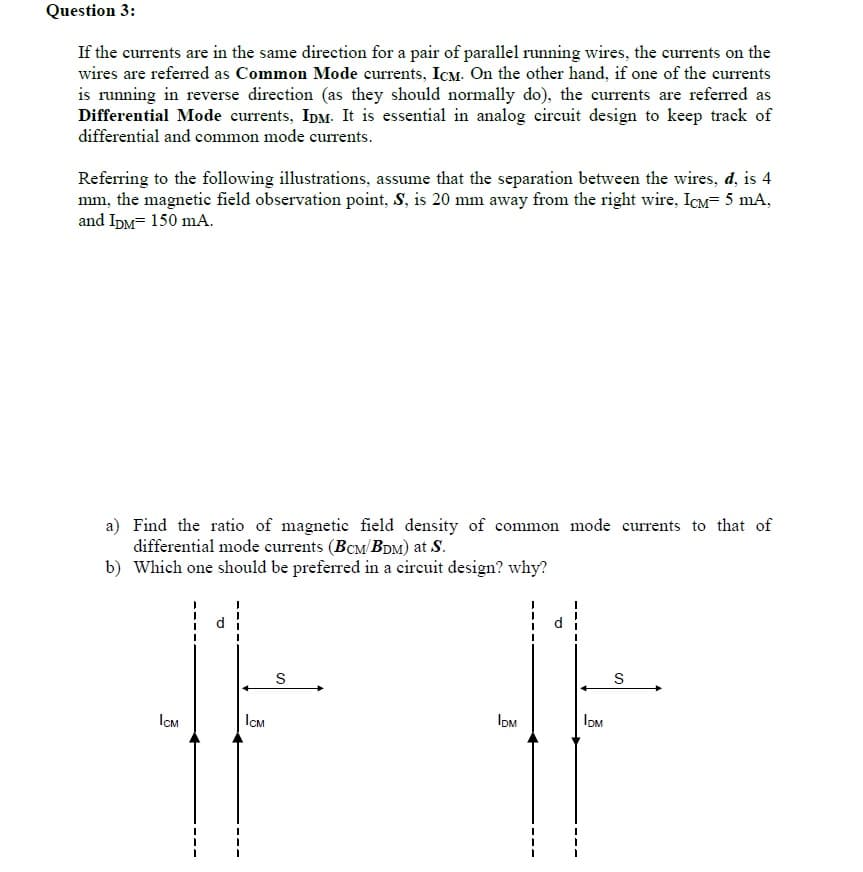If the currents are in the same direction for a pair of parallel running wires, the currents on the wires are referred as Common Mode currents, ICM. On the other hand, if one of the currents is running in reverse direction (as they should normally do), the currents are referred as Differential Mode currents, IpM. It is essential in analog circuit design to keep track of differential and common mode currents. Referring to the following illustrations, assume that the separation between the wires, d, is 4 mm, the magnetic field observation point, S, is 20 mm away from the right wire, IcM= 5 mA, and IpM= 150 mA. a) Find the ratio of magnetic field density of common mode currents to that of differential mode currents (BCM/BDM) at S. b) Which one should be preferred in a circuit design? why? d d. S ICM ICM IDM IOM
If the currents are in the same direction for a pair of parallel running wires, the currents on the wires are referred as Common Mode currents, ICM. On the other hand, if one of the currents is running in reverse direction (as they should normally do), the currents are referred as Differential Mode currents, IpM. It is essential in analog circuit design to keep track of differential and common mode currents. Referring to the following illustrations, assume that the separation between the wires, d, is 4 mm, the magnetic field observation point, S, is 20 mm away from the right wire, IcM= 5 mA, and IpM= 150 mA. a) Find the ratio of magnetic field density of common mode currents to that of differential mode currents (BCM/BDM) at S. b) Which one should be preferred in a circuit design? why? d d. S ICM ICM IDM IOM
College Physics
1st Edition
ISBN:9781938168000
Author:Paul Peter Urone, Roger Hinrichs
Publisher:Paul Peter Urone, Roger Hinrichs
Chapter23: Electromagnetic Induction, Ac Circuits, And Electrical Technologies
Section: Chapter Questions
Problem 23PE: Integrated Concepts Derive an expression for the current in a system like that in Figure 23.11,...
Related questions
Question

Transcribed Image Text:Question 3:
If the currents are in the same direction for a pair of parallel running wires, the currents on the
wires are referred as Common Mode currents, IcM. On the other hand, if one of the currents
is running in reverse direction (as they should normally do), the currents are referred as
Differential Mode currents, IpM. It is essential in analog cireuit design to keep track of
differential and common mode currents.
Referring to the following illustrations, assume that the separation between the wires, d, is 4
mm, the magnetic field observation point, S, is 20 mm away from the right wire, ICM= 5 mA,
and IDM= 150 mA.
a) Find the ratio of magnetic field density of common mode currents to that of
differential mode currents (BcM/BDM) at S.
b) Which one should be preferred in a circuit design? why?
d.
d
S
ICM
ICM
IoM
IOM
Expert Solution
This question has been solved!
Explore an expertly crafted, step-by-step solution for a thorough understanding of key concepts.
Step by step
Solved in 2 steps with 1 images

Knowledge Booster
Learn more about
Need a deep-dive on the concept behind this application? Look no further. Learn more about this topic, physics and related others by exploring similar questions and additional content below.Recommended textbooks for you

College Physics
Physics
ISBN:
9781938168000
Author:
Paul Peter Urone, Roger Hinrichs
Publisher:
OpenStax College


Physics for Scientists and Engineers: Foundations…
Physics
ISBN:
9781133939146
Author:
Katz, Debora M.
Publisher:
Cengage Learning

College Physics
Physics
ISBN:
9781938168000
Author:
Paul Peter Urone, Roger Hinrichs
Publisher:
OpenStax College


Physics for Scientists and Engineers: Foundations…
Physics
ISBN:
9781133939146
Author:
Katz, Debora M.
Publisher:
Cengage Learning

Physics for Scientists and Engineers, Technology …
Physics
ISBN:
9781305116399
Author:
Raymond A. Serway, John W. Jewett
Publisher:
Cengage Learning

College Physics
Physics
ISBN:
9781305952300
Author:
Raymond A. Serway, Chris Vuille
Publisher:
Cengage Learning

College Physics
Physics
ISBN:
9781285737027
Author:
Raymond A. Serway, Chris Vuille
Publisher:
Cengage Learning